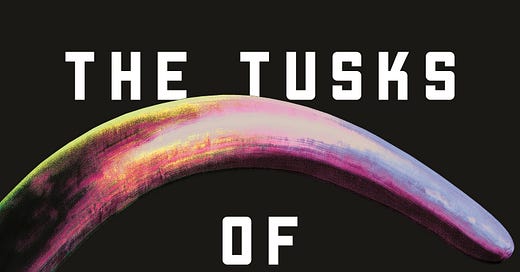The Tusks of Extinction by Ray Nayler
Jurassic Park meets Rise of the Planet of the Apes featuring resurrected Mammoths!!!!
Karma is a reincarnated resurrected Mammoth Matriarch is this riveting eco-thriller novella that pays homage to Jurassic Park while hewing away to make its own points
*********************************************************
The resurrection of the long-extinct Mammoth, guided by the digital consciousness of the only known expert on elephant behavior, fights back against poachers
**********************************************************
The Tusks of Extinction positions itself as an eco-thriller but the reality of the book is far different than what it posits to be, especially after you get past the first two chapters. Ray Nayler brings about all the pain and anguish related to the global poaching industry and channelizes that into this fabulous book that deals with memory, survival & greed once you get past the eco-thriller headline in the beginning.
“Whoever can remember is real. A being that remembers is alive, and authentic” - Dr Damira
The Jurassic Park influence is evident in the book specifically in the unintended consequences of the science gone wrong and the venality of men. The experiment of transferring a digital consciousness into the resurrected mammoth is a desperate move done for the right reasons. However, the scientists don’t reckon with the human emotions that the owner of the mind, Dr Damira brings to the table. Damira was a notable firebrand of a scientist, concerned with the protection of elephants and willing to take any step towards that. Now embedded within the mammoth matriarch, she brings that same approach coupled with the human appetite for problem-solving, including hunting the hunters ruthlessly, to keep the herd safe.
But as I said before, the eco-thriller concept is just on the surface. Digging in deeper, the book focuses a lot on memories. Dr Damira, our window to the world, exists in a memory stream with her past often colliding and influencing her present. Her experiences growing up, her passion towards elephants and her hatred towards poachers shape the mammoth she is inhabiting even as her memories help keep the herd safe while at the same time exhibiting behavior that other mammoths find very different. The non-linear storytelling that the author uses serves this purpose well – essentially helping us establish who Damira is in bits and pieces while using those experiences to guide her actions centuries later.
“The act of killing an animal in order to take something that was a part of them - and turn it into something you merely sold. It was the act of digging in and disturbing the earth that was cursed” - Svyatoslav
This story's second point of view is a 16-year-old poacher, Svyatoslav. Pushed into this life by his father, after the death of his mother, Svyatoslav wants a different life but knows no other way. Svyatoslav is a quick study, possessing a sharp mind and isn’t as rough as the poachers he interacts with therefore standing out as an interloper. He is also mature in knowing that the poachers are just part of the value chain & exist to just ensure that the rich & powerful get the ivory and that the poachers themselves do not make the wealth out of this dastardly deed. His point of view essentially serves as an uneasy alternate view to Damira’s and when these collide, the story takes on a pretty interesting turn
“Power was the ability to destroy without needing to. To do it not out of necessity, but as an act of pure excess. To do something to someone else because you could. And this was perhaps the greatest power of all: to kill something that no one else could kill" - Vladimir
The final point of view is that of Vladimir who is tagging along with his husband, Antony on this ride. Antony comes from power and wealth in society and like all those bored with their standing in society, seeks new thrills in forbidden experiences while hiding behind socially accepted norms. Antony’s story through Victor’s eyes shows that while society can evolve on certain human standards like acceptance of same-sex marriage (that too in Russia) – the atavistic lust for power & blood never fades away. The baser mentality of a primal creature remains and the author takes great pleasure in expressing his disgust at those who hunt and hide using weapons against these creatures and pass it off as bravery and prestige in society
These three storylines come together even as the author explores the unholy nexus of science and commerce (a Crichton staple), resulting in a fair amount of bloodshed & moral conflicts. In a story, the journey often is as important as the destination. Given that this is a novella, packed with tons of stuff without any bloat, the resolution feels a bit incomplete like there is more of the story to tell. However, the journey is an absolutely riveting one. The book is packed with fabulous dialogs and insights into the human condition. If nothing else, the book serves as a mirror expressing the weariness, disgust and cynicism that we as a society project, especially towards other species sharing the planet.
The one quibble as I had pointed out earlier is that it takes a couple of chapters to get a sense of what is happening. Reading the synopsis of the book helps anchor the reader before diving deep into the story. There are a lot of elements in the story that I can drill deep into, that this review cannot cover. There are elements of Damira’s past especially on how education changed her that resonated deeply. The nexus of science and commerce is another that one can explore as well
Overall, a terrific read that nails character aspects in a relatively short span and tries its best to wake us up to the scourge of poaching and the power dynamics that fuel this demand
Rating – 4 Resurrected Mammoths on 5




